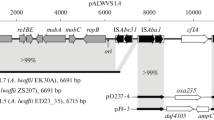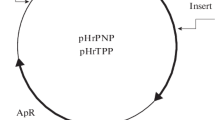Summary
Acetobacter xylinum contains a complex system of plasmid DNA molecules. Plasmids of molecular weights or copy numbers different from the original wild-type, are found in different types of mutants. Restriction endonuclease digestion and DNA/DNA hybridization analysis, showed that the plasmids often contained partly, but not completely the same DNA sequences. Two of these plasmid classes were analysed in more detail, and could be shown to differ in size by about 5 kb. Hybridization analysis using cloned DNA fragments as probes, showed that sequences lacking in the smallest plasmid were still present in a DNA fraction co-migrating with linearized chromosomal DNA. In addition, at least part of the DNA in the smallest plasmid was present both in the plasmid and chromosomal DNA fraction. Analysis of a particular strain containing an insertion of transposon Tn1, also indicated the existence of complex interactions between plasmids and chromosomal DNA. Together with experiments on conjugative transfer and curing of the plasmids, the results indicate that at least part of the genetic system of A. xylinum is unusual when compared to that of other genetically characterized bacteria.
Similar content being viewed by others
References
Bachmann BJ (1983) Linkage map of Escherichia coli K-12, edition 7. Microbiol Rev 47:180–230
Bittner M, Kupferer P, Morris CF (1980) Electrophoretic transfer of proteins and nucleic acids from slab gels to diazobenzyloxymethyl cellulose or nitrocellulose sheets. Anal Biochem 102:459–471
Bolivar F, Rodriguez RL, Greene PJ, Betlach MC, Heyneker HL, Boyer HW, Crosa JH, Falkow S (1977) Construction and characterization of new cloning vehiches. II. A multipurpose cloning system. Gene 2:95–113
Boyer HW, Roulland-Dussoix D (1969) A complementation analysis of the restriction and modification of DNA in Escherichia coli. J Mol Biol 41:459–472
Dagert M, Ehrlich SD (1979) Prolonged incubation in calcium chloride improves the competence of Escherichia coli cells. Gene 6:23–28
Depicker H, De Wilde M, De Vos G, De Vos R, Van Montagu M, Schell J (1980) Molecular cloning of overlapping segments of the nopaline Ti plasmid pTiC58 as a means to restriction endonuclease mapping. Plasmid 3:193–211
Ebert K, Goebel W, Moritz A, Rdest U, Surek B (1986) Genome and gene structures in Halobacteria. System Appl Microbiol 7:30–35
Fukaya M, Okumura H, Masai H, Uozumi T, Beppu T (1985a) Construction of new shuttle vectors for Acetobacter. Agric Biol Chem. 49:2083–2090
Fukaya M, Tayama K, Okumura H, Masai H, Uozumi T, Beppu T (1985b) Improved transformation method for Acetobacter with plasmid DNA. Agric Biol Chem 49:2091–2097
Fukaya M, Iwata T, Entani E, Masai H, Uozumi T, Beppu T (1985c) Distribution and characterization of plasmids in acetic acid bacteria. Agric Biol Chem 49:1349–1355
Grinsted J, Bennett PM, Higginson S, Richmond MH (1978) Regional preference of insertion of Tn501 and Tn802 into RP1 and its derivatives. Mol Gen Genet 166:313–320
Hansen JB, Olsen RH (1978) Isolation of large bacterial plasmids and characterization of the P2 incompatibility group plasmids pMG1 and pMG5. J Bacteriol 135:227–238
Heumann W, Rösch A, Springer R, Wagner E, Winkler K-P (1984) In Rhizobiaceae five different species are produced by rearrangements of one genome, induced by DNA-damaging agents. Mol Gen Genet 197:425–436
Inoue T, Fukuda M, Yano K (1985) Efficient introduction of vector plasmids into acetic acid bacteria. J Ferment Technol 63:1–4
Maniatis T, Fritsch EF, Sambrook J (1982) Molecular cloning. A laboratory manual, Cold Spring Harbor Laboratory, Cold Spring Harrbor, New York
Meyers JA, Sanchez D, Elwell LP, Falkow S (1976) Simple agarose gel electrophoretic method for the identification and characterization of plasmid deoxyribonucleic acid. J Bacteriol 127:1529–1537
Okumura H, Uozumi T, Beppu T (1985) Construction of plasmid vectors and a genetic transformation system for Acetobacter aceti. Agric Biol Chem 49:1011–1017
Pfeifer F (1986) Insertion elements and genome organization of Halobacterium halobium. System Appl Microbiol 7:36–40
Rigby PWJ, Dieckmann M, Rhodes C, Berg P (1977) Labelling deoxyribonucleic acid to high specific activity in vitro by nicktranslation with DNA polymerase I. J Bacteriol 113:237–251
Sadoff HL, Shimei B, Ellis S (1979) Characterization of Azotobacter vinelandii deoxyribonucleic acid and folded chromosomes. J Bacteriol 138:871–877
Schell J, De Ley J (1962) Variability of acetic acid bacteria. Antonie van Leeuwenhoek 28:445–465
Schrempf H (1985) Genetic instability: Amplification, deletion, and rearrangement within Streptomyces DNA. In: Leive L (ed) Microbiology 1985, American Society for Microbiology, Washington DC. pp 436–440
Shimwell JL (1956) Transmutation of species in the genus Acetobacter. J Inst Brew 62:339–343
Shimwell JL (1959) A re-assessment of the genus Acetobacter. Antonie van Leeuwenhoek 25:49–67
Shimwell JL, Carr JG (1964) Mutant frequency in Acetobacter. Nature 201:1051–1052
Steel R, Walker TK (1957) A comparative study of cellulose producing cultures and celluloseless mutants of certain Acetobacter spp. J Gen Microbiol 17:445–452
Timmis KN, Cabello F, Cohen SN (1978) Cloning and characterization of EcoRI and HindIII restriction endonuclease-generated fragments of antibiotic resistance plasmids R6-5 and R6. Mol Gen Genet 162:121–137
Valla S, Kjosbakken J (1981) Isolation and characterization of a new extracellular polysaccharide from a cellulose-negative strain of Acetobacter xylinum. Can J Microbiol 27:599–603
Valla S, Kjosbakken J (1982) Cellulose-negative mutants of Acetobacter xylinum. J Gen Microbiol 128:1401–1408
Valla S, Coucheron DH, Kjosbakken J (1983) Acetobacter xylinum contains several plasmids: Evidence for their involvement in cellulose formation. Arch Microbiol 134:9–11
Valla S, Coucheron DH, Kjosbakken J (1986) Conjugative transfer of the naturally occurring plasmids of Acetobacter xylinum by incP-plasmid-mediated mobilization. J Bacteriol 165:336–339
Wahl GM, Stern M, Stark GR (1979) Efficient transfer of large DNA fragments from agarose gels to diazobenzyloxymethylpaper and rapid hybridization by using dextran sulfate. Proc Natl Acad Sci USA 76:3683–3687
Wieslander L (1979) A simple method to recover intact high molecular weight RNA and DNA after electrophoretic separation in low gelling temperature agarose gels. Anal Biochem 98:305–309
Author information
Authors and Affiliations
Additional information
Communicated by H. Saedler
Rights and permissions
About this article
Cite this article
Valla, S., Coucheron, D.H. & Kjosbakken, J. The plasmids of Acetobacter xylinum and their interaction with the host chromosome. Mole Gen Genet 208, 76–83 (1987). https://doi.org/10.1007/BF00330425
Received:
Issue Date:
DOI: https://doi.org/10.1007/BF00330425




